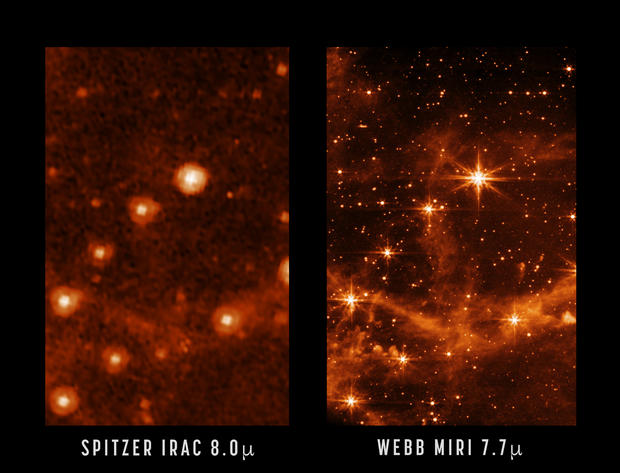James Webb Space Telescope Captures Sharp Views Of Invisible Light
(CNN) -- The James Webb Space telescope has the sharpest perspective on otherwise invisible light in the universe.
The highly anticipated first science images by the world's premier space observatory aren't expected until this summer. But recent test images captured by the telescope during its final commissioning phase are providing a glimpse of what's to come.
"These are the sharpest infrared images ever taken by a space telescope," said Michael McElwain, Webb observatory project scientist at NASA's Goddard Space Flight Center in Greenbelt, Maryland, during a news conference Monday.
Webb will be able to peer inside the atmospheres of exoplanets and observe some of the first galaxies created after the universe began by observing them through infrared light, which is invisible to the human eye. The images were taken after the successful alignment of the telescope's massive golden mirror segments. The test images show the clear, well-focused images that the observatory's four instruments are capable of capturing.
But the most striking result came from a comparison of images taken of the same target by Webb's Mid-Infrared Instrument with the now-retired Spitzer Space Telescope's Infrared Array Camera.
Spitzer, once one of the space telescopes belonging to NASA's Great Observatories program, was the first to capture high-resolution of images of the universe in near and mid-infrared light.
Webb's giant mirror and sensitive detectors can pick up even more detail -- and allow more discoveries -- than Spitzer could.
Scientists studying the two images of the Large Magellanic Cloud, a small neighboring galaxy of the larger Milky Way, noted that Webb's image reveals unprecedented details of interstellar gas between the stars.
"You can appreciate that the images from Webb are going to be better because we have 18 segments, every one of which is larger than the single segment, so to speak, that formed the Spitzer telescope's mirror," said Marcia Rieke, principal investigator for Webb's Near-Infrared Camera and regents professor of astronomy at the University of Arizona, during the news conference.
"But it's not until you actually see the kind of image that it delivers that you really internalize and go, 'Wow, just think of what we're going to learn.' Spitzer taught us a lot. This is like a whole new world."
Nearing the starting line
Webb is now in the final phase of preparation before it will be ready to begin conducting science observations.
"I would call this the homestretch," McElwain said. "We've had about 1,000 activities planned for commissioning, and there are only about 200 activities left to complete."
Webb's instruments are going through their final checkouts and calibrations as the telescope's team on the ground assesses the performance of each one to ensure they are ready to properly collect data.
Every instrument has about four or five science modes each that needs to meet specific criteria. One of Webb's special modes includes moving target tracking, which is especially helpful for scientists who want to study objects on the icy reaches of our solar system as they orbit the sun.
"When this phase is completed, we'll be ready to turn the science instruments loose on the universe," McElwain said.
The first images
Webb's first images of the universe, called the early release observations, or EROs, are expected to come out in mid-July, said Klaus Pontoppidan, Webb project scientist at the Space Telescope Science Institute in Baltimore, during the press conference. A more precise date will be shared later, he said.
These first "spectacular color images" will show that Webb is fully operational and a celebratory "beginning of many years of science," Pontoppidan said.
The exact targets of Webb for these first images haven't been revealed because the telescope team doesn't want to spoil the surprise. And those targets could change as the team gets closer to capturing images.
The first images will resemble what we're used to seeing from the Hubble Space Telescope in terms of aesthetic quality, Pontoppidan said.
"Astronomy is not going to be the same again once we see what (Webb) can do with these first observations," said Christopher Evans, Webb project scientist at the European Space Agency, during the news conference.
The-CNN-Wire
™ & © 2022 Cable News Network, Inc., a WarnerMedia Company. All rights reserved.




